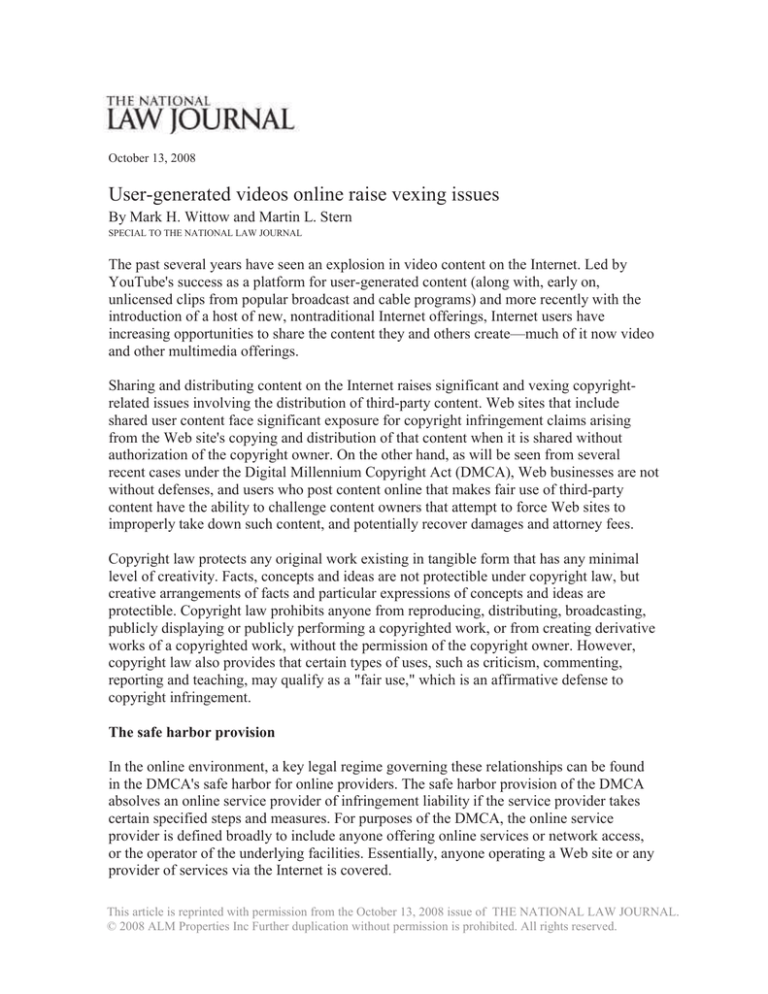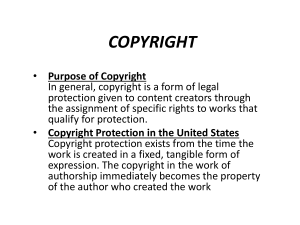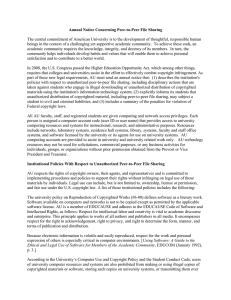
October 13, 2008
User-generated videos online raise vexing issues
By Mark H. Wittow and Martin L. Stern
SPECIAL TO THE NATIONAL LAW JOURNAL
The past several years have seen an explosion in video content on the Internet. Led by
YouTube's success as a platform for user-generated content (along with, early on,
unlicensed clips from popular broadcast and cable programs) and more recently with the
introduction of a host of new, nontraditional Internet offerings, Internet users have
increasing opportunities to share the content they and others create—much of it now video
and other multimedia offerings.
Sharing and distributing content on the Internet raises significant and vexing copyrightrelated issues involving the distribution of third-party content. Web sites that include
shared user content face significant exposure for copyright infringement claims arising
from the Web site's copying and distribution of that content when it is shared without
authorization of the copyright owner. On the other hand, as will be seen from several
recent cases under the Digital Millennium Copyright Act (DMCA), Web businesses are not
without defenses, and users who post content online that makes fair use of third-party
content have the ability to challenge content owners that attempt to force Web sites to
improperly take down such content, and potentially recover damages and attorney fees.
Copyright law protects any original work existing in tangible form that has any minimal
level of creativity. Facts, concepts and ideas are not protectible under copyright law, but
creative arrangements of facts and particular expressions of concepts and ideas are
protectible. Copyright law prohibits anyone from reproducing, distributing, broadcasting,
publicly displaying or publicly performing a copyrighted work, or from creating derivative
works of a copyrighted work, without the permission of the copyright owner. However,
copyright law also provides that certain types of uses, such as criticism, commenting,
reporting and teaching, may qualify as a "fair use," which is an affirmative defense to
copyright infringement.
The safe harbor provision
In the online environment, a key legal regime governing these relationships can be found
in the DMCA's safe harbor for online providers. The safe harbor provision of the DMCA
absolves an online service provider of infringement liability if the service provider takes
certain specified steps and measures. For purposes of the DMCA, the online service
provider is defined broadly to include anyone offering online services or network access,
or the operator of the underlying facilities. Essentially, anyone operating a Web site or any
provider of services via the Internet is covered.
This article is reprinted with permission from the October 13, 2008 issue of THE NATIONAL LAW JOURNAL.
© 2008 ALM Properties Inc Further duplication without permission is prohibited. All rights reserved.
The DMCA safe harbor provision, 17 U.S.C 512, insulates online service providers from
infringement liability if they adhere to certain guidelines and promptly block access to
allegedly infringing material (or take down such material from their systems) upon
notification of infringement. Under § 512(c), a service provider will not be liable for
copyright infringement resulting from activity by a user if the service provider lacks
knowledge of the infringing activity, does not receive a financial benefit directly
attributable to the infringement and acts expeditiously to remove or block access to the
infringing content once notice is given. Additionally, service providers must adopt, inform
users of and implement a policy that terminates the accounts of users who are repeat
infringers and must not interfere with "standard technical measures" that a copyright owner
uses to protect its work from infringement.
Finally, in most cases, the online service provider must have formally designated an agent
to receive notifications of claimed infringement, register that agent with the U.S. Copyright
Office and list the contact information for that agent on the service provider's Web site.
The safe harbor guidelines are strictly enforced, but as can be seen from a number of recent
cases, when followed, they also provide a potent defense.
For example, in Io Group v. Veoh, No. 06-3926, 2008 WL 4065872 (N.D. Calif. Aug. 27,
2008), the court dismissed a copyright infringement lawsuit concerning 10 adult videos
that third-party users had uploaded to the Veoh online video-sharing network,
www.veoh.com. Rather than sending a take-down notice to Veoh as required by the
DMCA, the Io Group instead filed a copyright infringement suit after Io Group's tawdry
videos appeared on the Veoh Web site. The court agreed with Veoh's assertion of the
DMCA safe harbor defense, noting that Veoh had a designated copyright agent, had a
practice of promptly responding to take-down notices, banned submissions from users who
had previously submitted infringing material and had technology to mark removed
copyrighted materials in order to prevent those files from being uploaded to its site again.
Liability may have attached if a take-down notice was sent and the videos remained on the
site. But in the absence of a take-down notice, Veoh could not be charged with knowledge
of the infringing work, and was protected by the safe harbor.
The court broke new ground on the question of what constitutes control of the content for
purposes of assessing that element of the safe harbor defense. Essentially, Io argued that
Veoh's automatic conversion of submitted files from their native format into the Flash
video format constituted control of the content for purposes of the safe harbor analysis. In
the court's view, however, an automated conversion system simply enabled Web site users
to access content on the site and did not bring infringing content within the control of
Veoh.
In another significant case decided in August, a court in the Northern District of California
vindicated a mother's right to continue to display a short (29-second) video of her toddler
son bouncing along to the venerable Prince recording of "Let's Go Crazy," played
identifiably (but not in high fidelity) in the background. See
www.youtube.com/watch?v=N1KfJHFWlhQ. In Lenz v. Universal Music Corp., No. 073783 (N.D. Calif. Aug. 20, 2008), the court determined that the copyright owner, Universal
-2-
Music Group, needed to consider possible fair use arguments before requesting in good
faith that a Web site take down the material. Universal sent YouTube a take-down notice,
and Lenz responded with a counternotification, asserting that her video was fair use.
Although YouTube ultimately reinstated the video, Lenz, represented by the Electronic
Freedom Foundation, asserted a violation of 17 U.S.C. 512(f), which permits a court to
impose damages and attorney fees on a copyright owner that "knowingly materially
misrepresents" to an online service provider that infringing content is appearing on the
service provider's Web site. Universal moved to dismiss, contending that copyright owners
should not be required to evaluate fair use prior to sending a take-down notice. The court
disagreed, in a decision that should send shivers down the backs of content owners
everywhere that have in place aggressive content take-down programs.
The court reasoned that fair use is a lawful use of a copyrighted work and therefore should
be considered by the copyright owner in order for the copyright owner to have a "good
faith belief" that infringement is occurring. The court further held that an allegation that a
copyright owner acted in bad faith by seeking to take down a copyrighted work without
considering fair use is sufficient to state a misrepresentation claim under § 512(f). Whether
Lenz's use in fact was a fair use has not yet been evaluated. But if the Lenz decision stands,
copyright owners will need to add some consideration of fair use to the determination of
when a take-down notice should be sent, instead of automatically assuming that every
unauthorized use is wrongful and worthy of a take-down request.
Clarifying the take-down policy
One important decision from 2007 also helps clarify the contours of the safe harbor
procedures and requirements. The 9th U.S. Circuit Court of Appeals opinion in Perfect 10
Inc. v. CCBill LLC, 488 F.3d 1102 (9th Cir. 2007), specifically addressed a service
provider's responsibility to block repeat copyright offenders. Perfect 10, the owner of an
adult-oriented business, which includes a Web site containing images of models, sued a
Web hosting company, CWIE LLC, and an online credit card service, CCBill LLC, raising
copyright, trademark and state unfair competition, false advertising and right of publicity
claims (among others).
With respect to the copyright claims, the 9th Circuit clarified what constituted a reasonable
implementation of the required take-down policy. The court determined that a service
provider met the safe harbor requirements if it had a procedure for addressing copyright
infringement notifications and did not prevent copyright owners from obtaining the
information needed to provide those notifications. Perfect compliance in implementing the
policy was not required.
Additionally, the court held that although the service provider had a duty to deny access to
repeat infringers, the service provider was not required to identify them — that burden fell
on the copyright owner. Also of interest in Perfect 10 is its thorough analysis of the scope
of protection offered for transitory digital network communications. That section provides
a broad grant of immunity to service providers that serve as conduits for the
-3-
communications by others, such as the provision of instant messaging or similar
communications. The court recognized that the Internet is a series of computer-tocomputer transmissions of data, and emphasized that "the Internet as we know it simply
cannot exist if those intervening computers must block indirectly infringing content." 488
F.3d at 1116.
Best practices in fair use
Two groups at American University in Washington have stepped into the fray, with their
release in July, in collaboration with a number of legal scholars, of a "Code of Best
Practices in Fair Use for Online Video." See www.centerforsocialmedia.org. The 2008 best
practices, intended as "a guide to current acceptable practices," include six principles with
associated limitations corresponding to common fair use situations, stated as follows:
commenting on or critiquing copyrighted material; using copyrighted material for
illustration or example; capturing copyrighted material incidentally or accidentally;
reproducing reposting or quoting in order to memorialize, preserve or rescue an
experience, an event or a cultural phenomenon; copying, reposting and recirculating a
work or part of a work for purposes of launching a discussion; and quoting in order to
recombine elements to make a new work that depends for its meaning on (often unlikely)
relationships between the elements. The best practices are new and have yet to be
judicially tested or cited by a court, and it will be interesting to see the extent to which they
get traction.
Other countries also are grappling with shared user content issues. A recent BNA report
indicated that the Paris Court of Grand Instance ruled, in M6 Web v. Wizzgo.com (Aug. 6,
2008), that wizzgo.-com, a free Web site that allows users to make online copies of
digitally broadcast TV programs, violated the copyright owner's rights and rejected
Wizzgo's argument that its service qualified it for the "private copy" exception available
under French law, corresponding somewhat to the times-shifting fair use defense available
in the United States under Sony Corp. of America v. Universal City Studios, 464 U.S. 417
(1984).
The Wizzgo decision stands in contrast to developing law in the United States that is
notable for its narrow reading of the requirements for direct liability for copyright
infringement. For example, in The Cartoon Network L.P. v. CSC Holdings Inc., 536 F.3d
121 (2d Cir. 2008), the 2d Circuit held that a cable-system provider of a centralized digital
video recording service did not directly infringe copyrights in recorded programs. The
court found that the buffer copy created by the system was too transitory to be fixed, and a
copy retained on a system hard drive was a single copy for later playback attributable to
the subscriber, not the cable operator. Although Cartoon Network does not directly address
shared user content or DMCA safe harbor issues, as do recent cases in the DMCA context,
it should provide some comfort to content users, and some concern to content owners
seeking strict limits on the use of their content.
Finally, many significant issues with respect to shared user content are at stake in the
ongoing litigation filed in 2007 by Viacom against YouTube in the Southern District of
-4-
New York, accusing YouTube of operating a business based on massive copyright
infringement. (One source that monitors YouTube take-downs has identified 9,308 videos
taken down by YouTube for alleged copyright violations. See http://YouTomb.mit.edu).
The court in that case has fielded a number of procedural and preliminary issues, including
the scope of discovery and the availability of punitive damages, but has not yet had to
address any substantive issues on the merits. Viacom Int'l Inc. v. YouTube Inc., nos. 07 Civ.
2103, 07 Civ. 3582 (S.D.N.Y. filed March 13, 2007).
Technology may yet overtake legal developments in this area, as recent news reports
indicate increasingly sophisticated capabilities to track and remove copyrighted material
from video sharing sites. Additionally, some copyright owners apparently are tolerating
unauthorized displays so long as they have the ability to place advertisements in proximity
to those displays, such as via the YouTube Video ID system. Clearly, the law in this area is
a work in progress, with the pendulum swinging in recent cases in favor of online
providers and users, and the recent 2008 best practices appearing decidedly "user friendly"
in the view of some. Whether those cases stand, whether the best practices are followed
and how the Viacom v. YouTube litigation is resolved are future developments to keep an
eye on. Stay tuned.
Mark H. Wittow is a partner in the intellectual property practice and Seattle office of K&L
Gates, and can be reached at mark.wittow@klgates.com. Martin L. Stern is a Washingtonbased partner in the firm's telecom, media and technology practice, and can be reached at
marty.stern@klgates.com.
-5-



